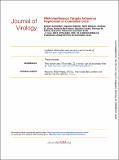Files in this item
RNA interference targets arbovirus replication in Culicoides cells
Item metadata
| dc.contributor.author | Schnettler, Esther | |
| dc.contributor.author | Ratinier, Maxime | |
| dc.contributor.author | Watson, Mick | |
| dc.contributor.author | Shaw, Andrew E. | |
| dc.contributor.author | McFarlane, Melanie | |
| dc.contributor.author | Varela, Mariana | |
| dc.contributor.author | Elliott, Richard M. | |
| dc.contributor.author | Palmarini, Massimo | |
| dc.contributor.author | Kohl, Alain | |
| dc.date.accessioned | 2013-08-06T15:31:01Z | |
| dc.date.available | 2013-08-06T15:31:01Z | |
| dc.date.issued | 2013-03 | |
| dc.identifier | 62951661 | |
| dc.identifier | 2ea033e2-6027-4b2c-8115-151308494b0a | |
| dc.identifier | 000314876900007 | |
| dc.identifier | 84874668728 | |
| dc.identifier.citation | Schnettler , E , Ratinier , M , Watson , M , Shaw , A E , McFarlane , M , Varela , M , Elliott , R M , Palmarini , M & Kohl , A 2013 , ' RNA interference targets arbovirus replication in Culicoides cells ' , Journal of Virology , vol. 87 , no. 5 , pp. 2441-2454 . https://doi.org/10.1128/JVI.02848-12 | en |
| dc.identifier.issn | 0022-538X | |
| dc.identifier.uri | https://hdl.handle.net/10023/3935 | |
| dc.description | This work was supported by United Kingdom Medical Research Council and Wellcome Trust. | en |
| dc.description.abstract | Arboviruses are transmitted to vertebrate hosts by biting arthropod vectors such as mosquitoes, ticks, and midges. These viruses replicate in both arthropods and vertebrates and are thus exposed to different antiviral responses in these organisms. RNA interference (RNAi) is a sequence-specific RNA degradation mechanism that has been shown to play a major role in the antiviral response against arboviruses in mosquitoes. Culicoides midges are important vectors of arboviruses, known to transmit pathogens of humans and livestock such as bluetongue virus (BTV) (Reoviridae), Oropouche virus (Bunyaviridae), and likely the recently discovered Schmallenberg virus (Bunyaviridae). In this study, we investigated whether Culicoides cells possess an antiviral RNAi response and whether this is effective against arboviruses, including those with double-stranded RNA (dsRNA) genomes, such as BTV. Using reporter gene-based assays, we established the presence of a functional RNAi response in Culicoides sonorensis-derived KC cells which is effective in inhibiting BTV infection. Sequencing of small RNAs from KC and Aedes aegypti-derived Aag2 cells infected with BTV or the unrelated Schmallenberg virus resulted in the production of virus-derived small interfering RNAs (viRNAs) of 21 nucleotides, similar to the viRNAs produced during arbovirus infections of mosquitoes. In addition, viRNA profiles strongly suggest that the BTV dsRNA genome is accessible to a Dicer-type nuclease. Thus, we show for the first time that midge cells target arbovirus replication by mounting an antiviral RNAi response mainly resembling that of other insect vectors of arboviruses. | |
| dc.format.extent | 14 | |
| dc.format.extent | 2551879 | |
| dc.language.iso | eng | |
| dc.relation.ispartof | Journal of Virology | en |
| dc.subject | Double stranded RNA | en |
| dc.subject | Bluetongue virus infection | en |
| dc.subject | Antiviral immunity | en |
| dc.subject | Mammalian cells | en |
| dc.subject | Mosquito cells | en |
| dc.subject | Sindbis virus | en |
| dc.subject | Aedes aegypti | en |
| dc.subject | RIG-I | en |
| dc.subject | Drosophila | en |
| dc.subject | Q Science | en |
| dc.subject.lcc | Q | en |
| dc.title | RNA interference targets arbovirus replication in Culicoides cells | en |
| dc.type | Journal article | en |
| dc.contributor.institution | University of St Andrews. Biomedical Sciences Research Complex | en |
| dc.contributor.institution | University of St Andrews. School of Biology | en |
| dc.identifier.doi | 10.1128/JVI.02848-12 | |
| dc.description.status | Peer reviewed | en |
| dc.identifier.url | http://europepmc.org/articles/PMC3571378 | en |
This item appears in the following Collection(s)
Items in the St Andrews Research Repository are protected by copyright, with all rights reserved, unless otherwise indicated.

